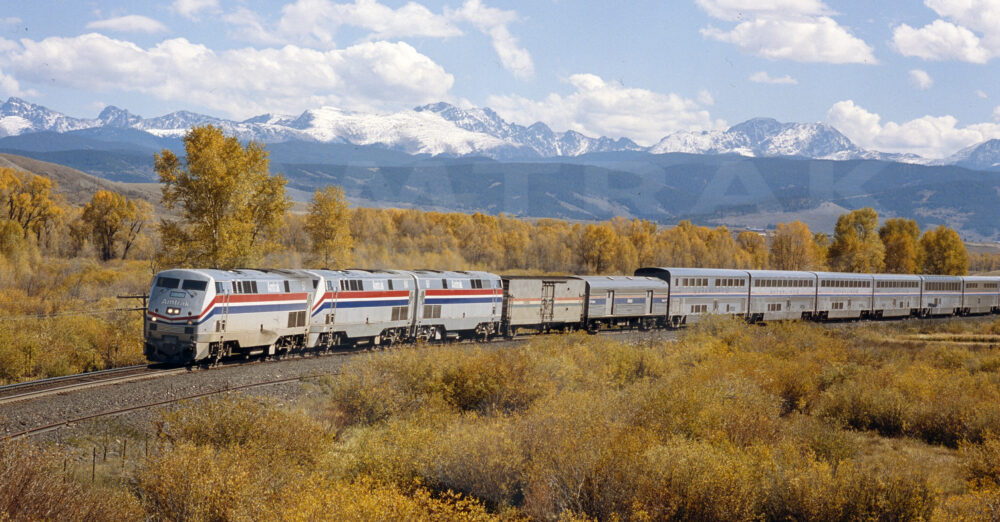Dealing with Late Trains.
If you’re a regular reader here, you already know that Amtrak has been having a problem with late trains. You also know that much of the blame for this issue falls on the freight railroads for ignoring the law and failing to give preference to Amtrak trains operating on their track.
To be clear, the point of this particular post is not about trains running 30 minutes late . . . or even an hour late. Stuff happens and it’s annoying . . . but we can live with it. The real problem is Amtrak trains that end up several hours—sometimes even many hours—late.
For example, two or three days ago, I made a routine check to see how Amtrak’s long-distance trains were doing. Most were OK, some were running 30 or 40 minutes late.

But it was not a good day for the eastbound California Zephyr. It had left the Bay Area on time, but things soon began to go wrong. Once the train was no longer in the “slot” provided by the freight railroad, the problems escalated. When I checked on it, the Zephyr had gotten as far east as Iowa where it was currently stopped . . . not moving . . . and was almost 15 hours late.
What could possibly account for being that late? I checked with an informed source: “What’s the scoop on Number Six?” Here’s the message that came back to me:
“Many issues. In the last week, there have been delays due to weather- related track washouts, a medical emergency on board, and the usual freight train interference. There is also quite a bit of track work along the way.
In other words, when it comes to long-distance train travel, sometimes stuff happens!
However, while the combination of issues the Zephyr encountered on the trip are not particularly unusual, the fact that this one train experienced ALL of these issues on the same trip is highly unusual.
So here’s my very best advice for travel on any one of Amtrak’s long-distance trains:
Plan for the possibility that your train could be more than just an hour or so late.
Don’t make connections from a long-distance train to another train; spend the night and continue your journey the following day.
If there is a delay, ask one of the conductors for a brief explanation of the reason. He or she should be more than willing the share that information. (I don’t care that we’ve stopped; but after five or ten minutes, I’d like to know WHY we’ve stopped.)
Finally, relax and—this is going to sound strange to first-time rail travelers—enjoy the extra time you’ll have on board.
Years ago, heading for Seattle on the Empire Builder, I was having lunch in the dining car with a man from England who was seeing the U.S. by train. The conductor stopped at our table to tell us that a freight train up ahead of us had broken down. He said the crew was fixing the problem, but he was estimating that we would now be four hours late into Seattle.
My British lunch mate was delighted. “Jolly good!“ he exclaimed, “Then we really are getting our money’s worth, aren’t we!”
And that—in just a few words—is the perfect attitude to take with you on a long-distance train ride!


I got lots of experience with late trains last month on a trip from Seattle to Colorado Springs. I took the Coast Starlight from Seattle to Sacramento, the Zephyr from Sacramento to Denver, and a connector bus to Colorado Springs, then retraced my steps. On the return trip I ignored the advice to spend the night. I figured the Zephyr was scheduled to arrive in Sacramento at 2:13pm and the northbound Starlight wasn’t due until almost midnight. I figured Amtrak could make that window.
On the way down our car attendant swore that the Starlight made Sacramento on time or even early about 90% of the time. I figured he was a fibber, but sure enough, we actually arrived 15 minutes early! I spent a lovely day in Sacramento going to museums and a Sacramento River Cats game.
The rest of the trip was not so timely. The westbound Zephyr was super late that day, which delayed its return the next day and we left Sacramento about five hours late. We got to Denver about 7 1/2 hours late, due mostly to a lengthy locomotive inspection in Grand Junction and the fact that it took about 45 minutes to get us the last hundred yards into Denver Union Station.
The return trip from Denver departed about 2 1/2 hours late, and it was all downhill from there. We traveled slowly in spots because of hot weather (and possibly warped rails) and waited several times for crew changes. By early afternoon I started thinking that we might actually miss the Starlight in Sacramento. We ended up arriving there 7 1/2 hours late, which didn’t really matter because the Starlight was 2+ hours late.
Woke up the next morning with a lovely view of Mt. Shasta as we waited behind a freight that was getting brake repairs. We sat in Portland for three hours–another locomotive inspection–and finally rolled into Seattle about 5:30am, a mere 9 1/2 hours late.
Alas. I wish they could do better.
Well, as there say, stuff happens . . . but, yes, we should be able to do better.